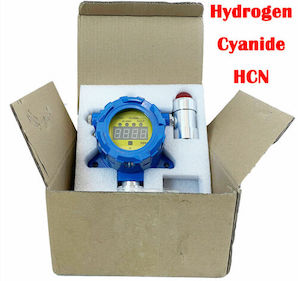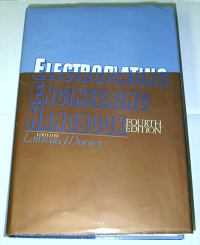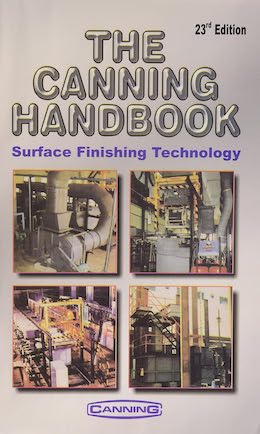
Curated with aloha by
Ted Mooney, P.E. RET

The authoritative public forum
for Metal Finishing 1989-2025

-----
Amateur D-I-Y Copper Plating at Home
Quickstart (no reader left behind):
As you may have seen demonstrated in high school science class, if you put an iron nail into a copper sulphate
⇦ this on
eBay or
Amazon [affil links] solution, a copper deposit will immediately form on the nail without any plating current applied. Although this is nice when that is what you'd like to do, it's bad news if you want to electroplate copper onto steel because such 'immersion deposits' offer virtually zero adhesion. To plate copper directly onto steel with good adhesion requires the use of a cyanide (deadly poison!) copper solution or a pyrophosphate (very tricky to maintain) copper solution, or a proprietary solution (probably expensive).
A reasonably simple work-around is to plate a thin layer of nickel onto the steel before doing the copper plating because nickel does not 'immersion deposit' on steel, and copper does not 'immersion deposit' on nickel. But the copper must be electroplated onto fresh nickel plating because nickel 'passivates' (acquires an oxide skins) nearly immediately.
Q. Hi there. I have been successfully plating nickel onto brass instruments for some time now, but when I move the nickel-plated brass to my copper solution (vinegar, salt+copper) I encounter the same problem you have been describing; a film quickly develops on the nickel and no plating actually occurs. The voltage is 8V. The parts are spotless: I go through many steps to insure my materials are clean. In the reading that I have done, copper should plate fine onto nickel, but that is not what I have found. What is the issue, and what can I do about it? Any help would be greatly appreciated, thanks.
Devon ThronessBrass Instrument Technician - Surrey, U.K.
October 28, 2021
A. Hi Devon. To the best of my knowledge, Tom Pullizzi, the co-founder of finishing.com, was the first to introduce this idea of plating from a solution of vinegar ⇦in bulk on eBay or Amazon [affil links] and salt. If you can find anything from before his postings in 1995, we'll be happy to acknowledge it. But his intention was to offer small children a safe solution from which to electroplate as a science demonstration; it wasn't intended or expected to be robust. So if you can produce robust nickel or copper plating this way, more power to you!
Are you trying to do copper plating onto fresh nickel plating? Nickel plating very quickly becomes passive (acquires an oxide skin) such that plating onto it with proper adhesion isn't possible.
Luck & Regards,

Ted Mooney, P.E. RET
Striving to live Aloha
finishing.com - Pine Beach, New Jersey
October 2021
⇩ Related postings, oldest first ⇩
Q. Help me copper plate my tin chess pieces! I have some tin chess pieces that I would like to put a copper plate on, so that I may see the difference between the "black" and the "white" pieces. I have tried to put the tin in a copper_sulphate / sulfuric acid bath, and running different amounts of current through, but the copper simply deposits, it doesn't plate. How can I activate the tin? I have a small chemistry lab at home, and I can get hold of all kinds of chemicals, but I need to find of what I should use. Any response is welcome.
Nils Henrik Tollefsen- Norway
1996
A. Hi, Nils. As you have discovered you usually can't use copper sulphate for copper plating for the exact reason you mentioned: it will immersion deposit as a dull non-adherent powder. The reason for this is that copper is more "noble" than tin, so putting tin in a copper solution creates a "battery" in the circuit that you have no control over. That "battery' causes the copper to spontaneously plate out at excessive speed, with no time for proper crystal growth.
Unfortunately, what you would really need is copper cyanide, but it's an extremely potent instantaneous acting poison which is totally inappropriate for home use. But you may be able to find a supplier of a proprietary copper pyrophosphate plating solution, which will prevent the spontaneous immersion deposit while being less dangerous than cyanide. This is a plating solution you would need to buy from a supplier, you can't make it yourself by mixing raw chemicals.
The best do-it-yourself real electroplating alternative if you are doing this for the learning experience rather than practical results would be to nickel plate the tin pieces first, and then copper plate them. But the most practical real alternative is probably copper-look paint instead of copper electroplating.
Plating is generally not something to do at home, I'm afraid, although I don't argue with those who are determined to do it. I just note that you might be better off just taking your chess pieces to a plating shop if you can find one.
Good luck.

Ted Mooney, P.E.
Striving to live Aloha
finishing.com - Pine Beach, New Jersey
Copper Plating of Steel for Home School Experiment
Q. I want to set up a home school experiment for my son about electroplating. If I fill a four inch steel pipe cap with copper sulphate and use a battery + in the solution and the - battery pole connected to the steel pipe cap, will the inside of the cap become coated. If so, what voltage battery would be correct? How long would it take to have a visible or completely covered surface?
Mike Swearingen- Georgetown, Texas
2001
A. Most "steel" pipe caps that I've seen are either painted black (black iron pipe) or galvanized. If there is no paint inside the cap, and you can get it CLEAN you will be on the way to a good experiment. Pumice ⇦ this on eBay or Amazon [affil links] and a scrub brush ⇦ this on eBay or Amazon [affil links] may be the best way to get it clean.
You have the polarity right, but copper will actually plate onto steel by "immersion". In other words, you will get a deposit of copper on the pipe cap even without a battery. But it will stop as soon as all the steel has a very thin layer of copper on it. It will happen in no more than a few minutes; it won't take days or weeks.
Subsequent application of about 1-1/2 volts will allow you to build a heavier layer of copper. Use a copper wire as the '+' pole, making sure exposed copper is in the solution but not touching the pipe.

Ted Mooney, P.E.
Striving to live Aloha
finishing.com - Pine Beach, New Jersey
Q. As a blacksmith I need a process to copper plate steel outside matte or brite finish.
Thank you,
Peter Bliss- Center City, Minnesota, USA
2001
Q. Dear Sir/Madam,
I have spent countless hours on the Internet looking for a step by step method of copper plating mild steel. So far all I have managed to come up with is countless reasons why it cannot be performed in the home workshop. I am well aware that toxic chemicals are involved, but if the information was readily available it might deter people like myself from experimenting and possibly causing a problem.
I am trying to electroplate a dome for a Van De Graff Generator to prevent it from rusting. I am building this generator from scrap parts, the dome is an old damaged gas canister that I have converted.
If I give up on the idea of copper plating, what other options do I have that will render a squeaky clean shiny conductive finish.
Happy New Year,
Ian Fisher- Greymouth, New Zealand
2003
by Jack Dini
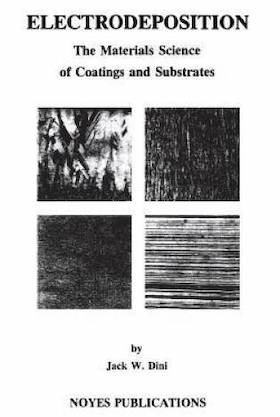
on eBay or
AbeBooks
or Amazon
(affil links)
by Kushner & Kushner
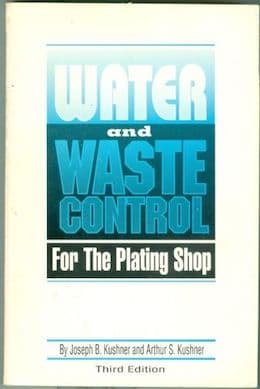
UTL on eBay
UTL on AbeBooks
on Amazon
(affil links)
A. Hi Ian,
You can easily apply a thin film of copper by swabbing on an immersion plating solution at room temperature. To keep the liquid from running off, apply only to the top and bottom surfaces. Rotate the dome as necessary to do the remainder. Rinse with DI water.
Solution: Add 15-16 g/L copper sulphate (CuSO4.5H2O)and 0.5-5* mL/L sulfuric acid to DI water.
*The higher sulfuric acid concentration may be better if traces of rust; 5 mL/L gives the solution used for testing passivated stainless steel; see MIL-STD-753
[⇦ this spec on DLA / cancelled] (replaced byAMSSTD753 ), Method 102 or ASTM A380
. These methods specify wetting the surface for 6 minutes, but it is much faster on ordinary steels. Note: I don't know whether this will be shiny; it looks rather flat on non-polished steel. If you aren't satisfied, nickel plating may be your best option.
- Goleta, California
Rest in peace, Ken. Thank you for your hard work which the finishing world, and we at finishing.com, continue to benefit from.
A. What would you do with the chemicals when you no longer want them? That is a much larger question. For roughly the price of a good variable voltage source and the cost of the chemicals you can have a professional plating done. As an ex plater, we spend years learning the trade, had a proper lab to control all of the vats, had a power source that would control to a tenth of a volt frequently with auto voltage or auto current control, temperature controls to a minimum of ± 1 °F, proprietary chemicals -- especially the brighteners, a copper cyanide strike and an acid copper heavy build tank. My personal reference library cost well over $2,000 US. Safety was an excellent exhaust system with a fume scrubber, Safety shower, eyewash, anti skid floor, professional waste treatment system, and prescription-only cyanide retardant first aid kit. Which part would you leave out? Most of your neighbors are freaked out paranoid about cyanide. In the USA, you would have a possibility of jail and fine if more than 2 knew about it.
Plating is a tough business. If home plating is so important, where is their web site and why haven't a single solitary one taken the time for a complete answer to questions by other home platers? Must be that they do not have time or do not want a visit from the Environmental police. So please do not bust our chops for not taking several hours to try to answer your question. Buy a book.
James Watts- Navarre, Florida
A. Hi cousin Ian. I've earned my living from this website for a long time, so I don't discourage using the Internet. But a few minutes at a library might be better than "countless hours on the Internet" because books are very carefully written for tutorial learning, slowly building knowledge on knowledge, whereas jumping around on the Internet can be a frustrating experience of being unable to understand some of what you're reading, while reading the same basic stuff a hundred times. There are more good plating books than you can count, and almost all of them will have instruction on copper plating of mild steel.
But please tell us what alloy this old damaged gas canister is made of, and the surface condition of the materials, and what you know about polishing and buffing. People may expect the plating to be smooth and reflective, even though it will be but a few ten thousandths of an inch thick and will follow the surface of the dinged, scratched, and gouged piece of scrap. That won't work; you need to get that old metal nice and smooth before you can copper plate it with any shine to it. Then your best bet will be to nickel plate it first, then copper plate it. Good luck.

Ted Mooney, P.E.
Striving to live Aloha
finishing.com - Pine Beach, New Jersey
Low budget Copper Anodes
Q. To save money from plating shops, I plate copper myself buff, plate, buff. The need for more copper anodes is an issue every month. My father owns a roofing company and has an abundance of copper flashing scraps. Can this be utilized for alkaline and acid baths? If so do I need anode bags? What do anode bags actually do. I have plated with and without bags and found no difference visually. Any additional info to aid in my plating process would be appreciated. Commercial battery charger ⇦ this on eBay or Amazon [affil links] and 6 gal setup.
Rusty Gillplating shop - Bunker Hill, West Virginia, USA
2004
A. I have 12,000 gallons of acid copper solution and 2200 gallons of alkaline copper solution in my shop. I am not aware of platers using discarded copper flashing, discarded jumper cables or antique wash boilers as anode material. Perhaps we're all a bunch of chumps. Friend, copper plating, as are all plating processes, is very sensitive to the purity of the anode material. What dissolves very well in an acidic environment will not dissolve nearly as well in an alkaline environment.
I would suspect that you might want to double bag your copper pipes you suspend in the bath because there's no telling what the content is. You might have lead, zinc, silver, tin and other nice stuff that will eventually lead to the complete contamination of your process and you'll end up having someone haul out your bath. Leave anode making to the anode makers.

Daryl Spindler, CEF
decorative nickel-chrome plating - Greenbrier, Tennessee
A. First let me say that if you have not had proper training in the handling and disposal of hazardous materials you should not be using a plating bath. That said, if you are using an acid copper solution the anode material is different than that used in cyanide alkaline copper and this in turn may be different than that used in alkaline non cyanide copper. Purity of the metal being used as the anode and the process chemicals equals good results. Remember the old expression "garbage in - garbage out". Also, the battery charger is suitable for cyanide alkaline copper but not for acidic baths due to the high ac ripple (actually in the alkaline bath this is helpful as it yields a result similar to pulse plating). Having said all the above, if you are not a trained professional you should not be plating.
Gene Packmanprocess supplier - Great Neck, New York
2004
Q. I am aware that I am not a professional, that would explain why this is listed in the hobbyist/amateur section of this site. Thank you for the response. What would be the ideal alloying metal and the percentages of a copper anode for an alkaline copper bath and acid bath?
Rusty Gill- Bunker Hill, West Virginia
2004
A. Hi Rusty. Electrolytically pure oxygen-free copper with a small percentage of phosphorous are available from plating industry vendors.
But if you want to use scrap copper, I suggest copper wire because wire is always very high purity copper whereas copper flashing may not be. Good luck.

Ted Mooney, P.E.
Striving to live Aloha
finishing.com - Pine Beach, New Jersey
Q. Another question: We are rotating electrical contacts (low voltage/amperage) to provide electrical contact with a stationary contact. The product is low volume so tooling for copper or aluminum isn't an option. Will copper or electro-nickel plating work on carbon steel on the rotating part? The stationary part can be real copper. Appreciate your insight.
Carl.
- Minnesota
February 26, 2010
A. Hi, Carl. Copper plating is not difficult for a professional, nor is nickel plating or electroless nickel plating. Electroless nickel is probably the most common contact materials these days. But remember that this type of plating tends to be on the order of magnitude of under one thousandth of an inch thick.
If it's slowly rotating for a limited time and a short lifespan, yes it will work. But anything that is a thousandth of an inch thick can wear rapidly under a rotational wear situation. Plus the electrical capacity of steel is only about 15 percent of copper, maybe a little less.
Luck and Regards,

Ted Mooney, P.E.
Striving to live Aloha
finishing.com - Pine Beach, New Jersey
A. All persons requesting info, there is no replacement for copper if a system /component needs the excellent requirements of copper, but, because of the criminal component of the modern establishment, copper plating on steel has became an answer on the problem. Even if the process of Cu plating to iron is a risky because of the solutions, there is a method to overcome this. sulfuric acid in the place of cyanide solutions can be used. The only issue is that the size of components to be Copper plated can be an issue as it has to be immersed completely in an electroplating bath to achieve the required thickness, etc.
boshoff [returning]Technical assistant - Pretoria south Africa
![]() Hi, Boshoff. I think there was a translation difficulty, and where you wrote "criminal component", perhaps "regulatory requirements" would be a better way to phrase it?
Hi, Boshoff. I think there was a translation difficulty, and where you wrote "criminal component", perhaps "regulatory requirements" would be a better way to phrase it?
But I disagree with your posting: to my knowledge you cannot successfully electroplate copper directly onto steel from a sulfuric acid copper plating solution because the copper will "immersion deposit" onto the steel with poor adhesion. I believe you must either electroplate the copper from a pyrophosphate bath or cyanide bath, or preplate the steel with nickel.
Regards and good luck,

Ted Mooney, P.E.
Striving to live Aloha
finishing.com - Pine Beach, New Jersey
Q. How you doing, name is Abe and I have a question. I'm a welder and I weld copper / silicon Bronze. I weld copper plates for the steel industry that are almost 2 inches thick by 2 ft long and 3 ft wide. It's come to my attention that it's possible to copper plate them at any size we usually weld them around 1/8 inch and sometime more depending on the wear and tear then it gets machined down to specifications. My question is, what is the limit on copper plating copper and how good the quality is? Thank you, Abe
Abe Ali- Jonesboro Arkansas
November 3, 2012
A. Hi Abe. It is possible to electroform (electroplate) copper to 1/4" thick and probably more. But it may not necessarily be possible to electroplate copper onto your copper plates to anywhere near that thickness because of stresses since the crystal structure of the plating will differ from the crystal structure of the substrate. Although I don't fully understand your situation, I think the answer will likely be that 1/8" thick plating is no "catalog item" and you would need to do significant development work in order to achieve it for a particular situation. Good luck.
Regards,

Ted Mooney, P.E.
Striving to live Aloha
finishing.com - Pine Beach, New Jersey
Q. Thank you for the info but most of the enquiries are from people at home who "like me want to restore some or other bits and pieces". Is there someone out there that can talk in "kitchen engineering": so much water, so many grams of copper sulphate, how many AMPS to ... !
We don't intend on suing anybody, we just want simple info!
I know it is a trade but we all have trade of some kind; please share!
Thanking you in advance.
les
- Bathurst, South Africa
October 13, 2014
A. Hi Les. But what are those "bits and pieces" made of? I don't know how to make it simpler than this: you can't successfully plate steel parts with copper sulphate with any amount of water, any number of grams of copper sulphate, any number of AMPS.
We have an FAQ that tells elementary school kids how to do some plating experiments, and you're welcome to do those experiments and start learning from them. But trade people are not refusing to share facts with you, they're literally shouting the facts at you: you have to use copper pyrophosphate or copper cyanide or nickel plating instead.
Regards,

Ted Mooney, P.E. RET
Striving to live Aloha
finishing.com - Pine Beach, New Jersey
Q. What chemicals are in the spray on copper coatings for steel?
Larry Tampke- Boerne, Texas
September 12, 2015
A. Hi Larry. Which "spray on copper coatings" are those? Ken has described a copper sulphate and sulfuric acid solution. That would probably be the basis of most spray on copper color coatings as well. But please don't keep it so abstract. Why do you ask, what are you trying to do? Thanks.
Regards,

Ted Mooney, P.E. RET
Striving to live Aloha
finishing.com - Pine Beach, New Jersey
Q. I'd like to use 16 ga REBAR wire on top of 16GA copper wire for NEO traction/power.
Wondering if amateur copper/nickel plating may delay any rusting, particularly below the MDF track surface, where the two wires contact. Not quite as concerned about the surface, since that can be easily removed.
THANKS!
novice HO slotcar track router - Nantasket Beach, Massachusetts USA
February 27, 2017
Q. Some have suggested above to plate steel with nickel first if you want to use relatively safe copper sulphate. I am brush plating a bicycle made of high carbon steel.
Today, after careful cleaning, I did the nickel plate using a modern watts solution with a bit of saccharin, thiourea
⇦ this on
eBay
or
Amazon [affil links] and sodium laurel sulphate. I raised solution to about 30 °C at the start. I plated the nickel at around 3 V (it is hard to hold constant with brush plating). It seemed to plate well.
Next I used an acid based solution with copper sulphate at 1 V. Despite the nickel layer, the copper ions went on to the nickel too fast and the result is a copper surface that is splotchy in color and can be rubbed off if rubbing hard with a paper towel. This occurs in some areas, not all. So I suspect the underlying nickel is uneven or non-existent, contrary to how it looked, which was good.
I should mention, this same process worked well in tests with mild steel and a watts nickel strike versus a full nickel plate. Here I used the boric acid based nickel plate instead of an HCl strike. That's one variable introduced today.
The second variable introduced today is working with high carbon steel vs. mild steel. This high carbon variable should have been nullified by the nickel plate. Note I did not bake the nickel plate on at 300 Deg to release hydrogen. But I doubt that is causing my problem.
I feel like I am back to square one here. So the pyrophosphate solution appears to be my only viable "home use" alternative. I am not inclined to go Cyanide. HCl 36% is about as risky as I want to get).
Any thoughts others might have are welcomed.
- Sparta, New Jersey USA
September 10, 2017
Q. Hi- I am making a stained glass "Tiffany" lampshade.
I have not had good luck with a professional finish simply by using a patina on the solder (solder is composed of a tin/lead combo).
I would like to try to copper plate it (myself, as professionals I called will not take on the project).
I have seen brush plating kits on the web and wondered whether these kits would produce results better than simple "copper" patina. I don't want to invest in a kit if the results won't produce a good plated finish. Thanks
- Pittsburgh, Pennsylvania USA
December 4, 2019
Q, A, or Comment on THIS thread -or- Start a NEW Thread
